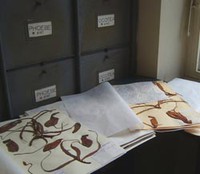Desks Piled High, and Lizards for Lunch

Herbaria refers to collections of dried plant specimens. These specimens are often mounted and then filed away. Oxford's herbaria, for example, contains approximately a million specimens. In any herbaria, it is common to find some samples that have not yet been identified.
According to Dr. Robert Scotland of Oxford University's Department of Plant Sciences, "Many people think that discovering new species is primarily about expeditions to exotic locations and collecting new specimens, but the truth is that thousands of new plant species are lying unidentified in cupboards, drawers and cabinets around the world."
In December, Science Daily ran an article with the headline, "35,000 New Species 'sitting in Cupboards.'" The 35,000 species under the microscope of that article account for approximately half of the species of flowering plants that scientists estimate have yet to be described and cataloged.
There are 70,000 species of plants—flowering ones—that haven't been tackled by scientists, but that we know exist and, as the article suggests, half of them are probably sitting on a desk somewhere or in a jar or maybe even pressed between the pages of an old dictionary. The report goes on to suggest that it can take 30-40 years between the time a new specimen is collected and the time it gets fully processed and described and included in the list of known species.
That's a staggering time delay! Think about it, the specimen collected by one scientist and shelved for later study may not be found or picked up again until years later—and by someone else!
Ordering the Daily Special
The problem plant scientists face, and the fact that plant specimens may be among the most documented of organisms (compared, for example, to insects), helps to explain how an undocumented species of lizard, Leiolepis ngovantrii, was on the menu—daily— in Vietnam last year without scientists even being aware that "lunch" for many diners at local restaurants was actually what amounts to a scientific delicacy—a new species of lizard, and not only that, but an all-female species that reproduces by cloning.
The story, reported by CNN in November, is worth reading. That by the time scientists arrived on the scene, a "mishap" in the kitchen had resulted in the current tank of lizards being grilled for lunch underscores how easy it can be to overlook (or eat) something new without even realizing its value to the scientific community.
The scientists who had rushed to Vietnam to investigate the lizards did, apparently, get to have lunch and found out that, contrary to popular wisdom, not everything tastes like chicken!
The Tip of the Biodiversity Iceberg
What these stories underscore is the fact that what we know is most likely far less than there still is to know in terms of identifying and measuring the biodiversity that surrounds us. There are millions of species still to be tracked and described and cataloged by researchers in all areas of science.
A recently-completed international Census of Marine Life took a decade to complete, but at the end, the census resulted in a list of 190,000 species of marine life, including approximately 6000 potentially new species. Based on the data collected, scientists involved estimate there may be at least a million marine species throughout the oceans, and at least tens of millions of types of marine microbes.
There's a lot of work to be done, and a lot of room for emerging scientists. Just remember, tracking biodiversity doesn't always mean a trip to an exotic location. Sometimes, it means simply looking around!
Look Around: The Next New Species May Be in Your Own Backyard
Students can begin investigating issues related to biodiversity with projects like these from the Science Buddies library of free Project Ideas:
- Making Species Maps (Difficulty: 1)
- Finding Phyla (Difficulty: 1)
- Bug Vacuums: Sucking up Biodiversity (Difficulty: 1-2)
- Making Species Maps (Difficulty: 1)
- Worm Hunt: Isolating Soil Nematodes from Your Backyard (Difficulty: 4)
- Germ Invasion (Difficulty: 6-8)
- Investigate Native Plant Evolution with Chloroplast Sequencing (Difficulty: 10)
Categories:
You Might Also Enjoy These Related Posts:
- Plastics and Earth Day - Science Projects
- Arduino Science Projects and Physical Computing
- 10+ Robotics Projects with the BlueBot Kit
- 5 STEM Activities with Marshmallow Peeps
- March Madness Basketball Science Projects: Sports Science Experiments
- Women in STEM! More than 60 Scientists and Engineers for Women's History Month
- Explore Artificial Intelligence and Machine Learning with Student AI Projects
- 10 Reasons to Do the Rubber Band Car Engineering Challenge









